Welcome to the world of sugar gliders, captivating little creatures that have become increasingly popular as exotic pets in recent years. Native to the forests of Australia, Indonesia, and New Guinea, sugar gliders are small, arboreal marsupials known for their gliding ability and adorable appearance.
If you’re considering bringing a sugar glider into your life, one of the important factors to consider is the sugar glider price in India. In this article, we will explore the topic of sugar glider price in India, providing you with insights into the factors that influence their cost and helping you make an informed decision about owning these delightful companions. Whether you’re a potential sugar glider owner or simply curious about the cost involved, read on to discover more about the price range and considerations associated with acquiring a sugar glider in India.
Average Sugar Glider Price In India
The average price of a sugar glider in India can vary depending on several factors, including the age, gender, lineage, coat color, and overall health of the glider. On average, you can expect to find sugar gliders price in India is between ₹8,000 to ₹25,000 or more.
It’s important to note that the sugar glider price in India can vary significantly from one breeder or seller to another. Breeders who specialize in rare or unique color variations may charge higher prices for their sugar gliders. Additionally, factors such as the breeder’s reputation, the glider’s lineage, and the glider’s temperament may also influence the sugar glider price in India.
When considering the sugar glider price in India, it’s essential to remember that the initial cost is just one aspect of owning these exotic pets. There are ongoing expenses for their proper care, including food, veterinary care, toys, housing, and enrichment activities.
It is highly recommended to purchase sugar gliders from reputable breeders or licensed pet stores to ensure that the gliders are healthy, well-socialized, and ethically sourced. It’s crucial to prioritize the welfare of the animals and support responsible breeders who prioritize the well-being of their sugar gliders.
Before bringing a sugar glider into your home, make sure to educate yourself about their needs, behavior, and care requirements to provide them with a happy and fulfilling life
Sugar Glider Price across different regions In India
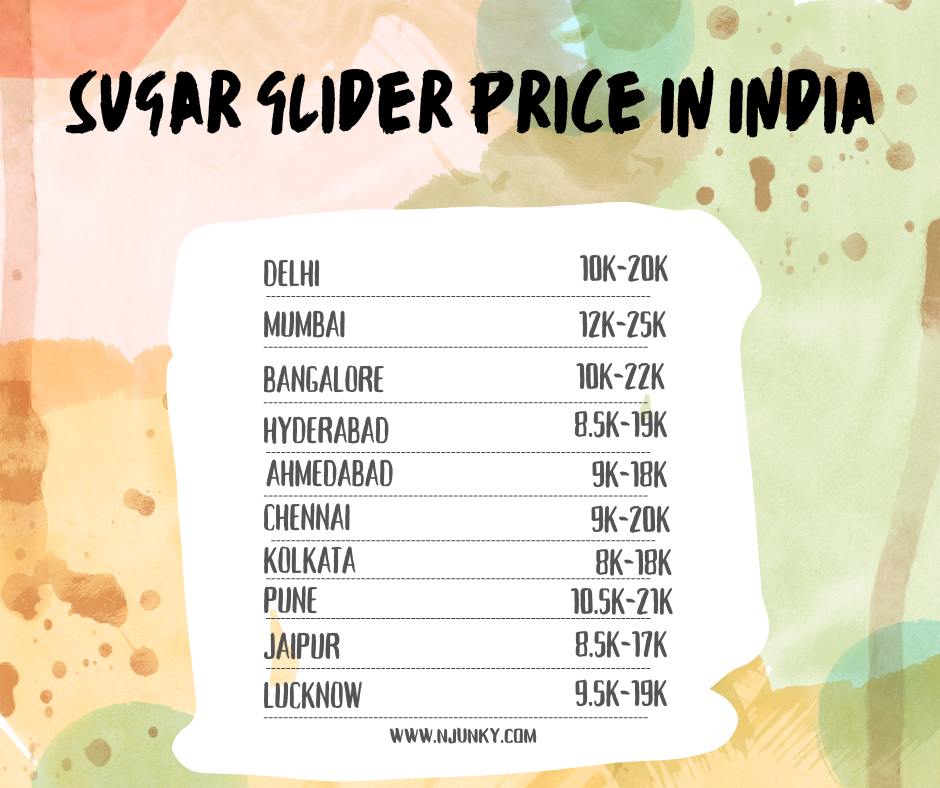
Sugar gliders have become increasingly popular as pets in India, with more and more people opting to keep these cute and friendly animals. However, the sugar glider price in India can vary greatly depending on the region where you are looking to buy one. In this article, we will take a look at the prices of sugar gliders across different regions in India.
| No | City | Average Sugar Glider Price (INR) |
| 1 | Sugar Glider Price In Delhi | ₹10,000 – ₹20,000 |
| 2 | Sugar Glider Price In Mumbai | ₹12,000 – ₹25,000 |
| 3 | Sugar Glider Price In Kolkata | ₹8,000 – ₹18,000 |
| 4 | Sugar Glider Price In Chennai | ₹9,000 – ₹20,000 |
| 5 | Sugar Glider Price In Bangalore | ₹10,000 – ₹22,000 |
| 6 | Sugar Glider Price In Hyderabad | ₹8,500 – ₹19,000 |
| 7 | Sugar Glider Price In Pune | ₹10,500 – ₹21,000 |
| 8 | Sugar Glider Price In Ahmedabad | ₹9,000 – ₹18,000 |
| 9 | Sugar Glider Price In Jaipur | ₹8,500 – ₹17,000 |
| 10 | Sugar Glider Price Lucknow | ₹9,500 – ₹19,000 |
| 11 | Sugar Glider Price Chandigarh | ₹10,000 – ₹20,000 |
| 12 | Sugar Glider Price In Kochi | ₹8,500 – ₹18,000 |
| 13 | Sugar Glider Price In Indore | ₹9,500 – ₹19,000 |
| 14 | Sugar Glider Price In Guwahati | ₹9,000 – ₹18,000 |
| 15 | Sugar Glider Price In Bhubaneswar | ₹8,500 – ₹17,000 |
Overview of Sugar Gliders
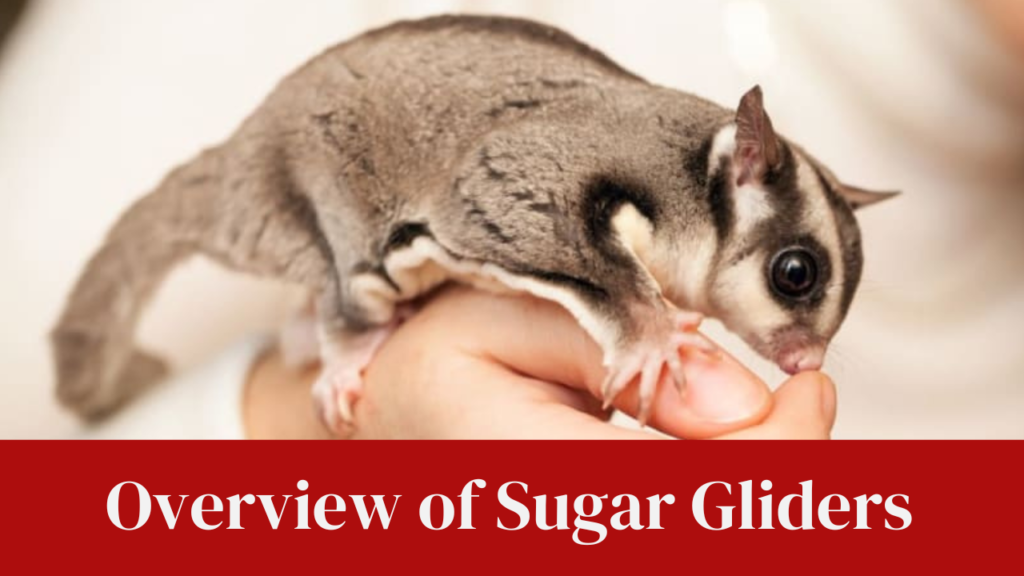
Sugar gliders are small, nocturnal marsupials native to the forests of Australia, Indonesia, and New Guinea. They are known for their endearing appearance, social nature, and remarkable gliding ability. Here’s an overview of some key aspects of sugar gliders:
Appearance: Sugar gliders have a distinct appearance with a compact body, large eyes, and a furry membrane called a patagium that extends from their wrists to their ankles. This patagium enables them to glide through the air, much like a flying squirrel.
Size: Adult sugar gliders typically measure about 5 to 6 inches in length, with a tail that can add an additional 6 to 7 inches. They weigh between 3.5 to 5.3 ounces, making them small and lightweight.
Behavior: Sugar gliders are highly social animals that live in colonies in the wild. They are known for their strong bond with their owners and require regular social interaction and companionship. They communicate through a variety of vocalizations, such as chirping, barking, and hissing.
Diet: In the wild, sugar gliders are omnivorous, feeding on a diet consisting of nectar, sap, fruits, insects, and even small vertebrates. In captivity, their diet typically consists of a balanced mixture of fruits, vegetables, insects, and a specialized sugar glider pellet food.
Housing: Sugar gliders require a spacious and vertically-oriented enclosure with multiple levels for climbing and exploration. The enclosure should be equipped with branches, ropes, and toys for mental stimulation. They also need a nesting box or pouch where they can sleep during the day.
Lifespan: With proper care, sugar gliders can live for about 12 to 15 years in captivity. However, it’s important to note that their lifespan can be influenced by factors such as diet, exercise, socialization, and overall health.
Legal Considerations: Before acquiring a sugar glider, it’s crucial to check the local laws and regulations regarding ownership. In some places, permits or licenses may be required to keep sugar gliders as pets.
Care and Maintenance: Sugar gliders require a specialized diet, regular veterinary check-ups, and an enriched environment to thrive. They also need a consistent schedule for feeding, playtime, and socialization to ensure their well-being.
History of Sugar Gliders in India
The history of sugar gliders in India as pets is relatively recent, with their popularity steadily increasing over the past decade. Sugar gliders are not native to India but are exotic animals that have gained attention among pet enthusiasts.
The import and introduction of sugar gliders to India began around the early to mid-2000s, primarily through authorized animal importers and breeders who specialized in exotic pets. As these small marsupials gained recognition for their unique appearance and sociable nature, more people started expressing interest in owning them as pets.
Initially, sugar gliders were relatively uncommon and mainly found in major cities with well-established exotic pet markets. However, with the rise of social media and the internet, the visibility and accessibility of sugar gliders increased significantly, reaching a wider audience across the country.
Today, sugar gliders can be found in various parts of India, and there are both authorized breeders and pet stores that offer these animals for sale. However, it’s important to note that the import and trade of exotic animals in India are regulated by wildlife conservation laws and guidelines to ensure the protection of native wildlife and prevent illegal trafficking.
As the popularity of sugar gliders continues to grow, it is crucial for potential owners to be aware of the responsibilities and care requirements associated with these animals. Ethical and responsible ownership is essential to safeguard the well-being of sugar gliders and support efforts to maintain the balance between conservation and the pet trade in India.
factors that influence the price of sugar gliders in India
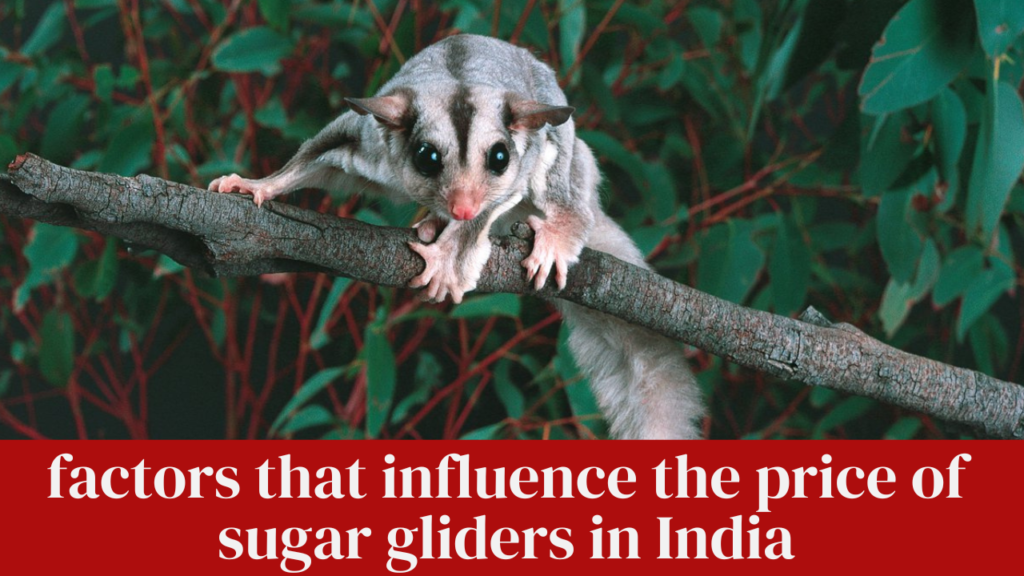
Several factors can influence the price of sugar gliders in India. Here are some key factors that can impact the sugar glider price in India:
Demand and Availability:
The demand and availability of sugar gliders in the market can significantly influence the sugar glider price in India. If there is a high demand for sugar gliders but limited availability, the price is likely to be higher. Conversely, if there is a lower demand or a surplus of sugar gliders, the price may be lower.
Age and Morph:
Age and morph (color variation) can affect the sugar glider price in India. Generally, younger sugar gliders tend to be more expensive than adults. Moreover, certain morphs or color variations may be rarer and more desirable, leading to higher prices.
Lineage and Genetics:
Sugar gliders with desirable lineage or genetics can command higher prices. Breeders may have specific bloodlines or genetic traits that are in demand, such as unique coat colors or patterns. Sugar gliders with documented lineage or exceptional traits may be priced higher.
Breeder Reputation:
The reputation and expertise of the breeder can also impact the pricing. Reputable breeders who prioritize the health, socialization, and well-being of their sugar gliders may charge higher prices for their animals.
Included Accessories and Services:
Some sellers may include additional accessories, such as cages, toys, or starter kits, which can influence the overall sugar glider price in India. Additionally, breeders who offer after-sales support, guidance, or health guarantees may charge higher sugar glider price in India to cover these services.
Geographic Location:
The location of the seller can play a role in pricing due to factors such as transportation costs and regional demand variations. Sugar gliders may be more expensive in certain regions due to higher operating costs or limited availability.
Legality and Licensing:
The legal requirements and licensing associated with sugar glider breeding and selling can impact the sugar glider price in India. Breeders who comply with regulations and have proper licenses may charge higher prices to cover their compliance costs.
Where to buy sugar gliders in India
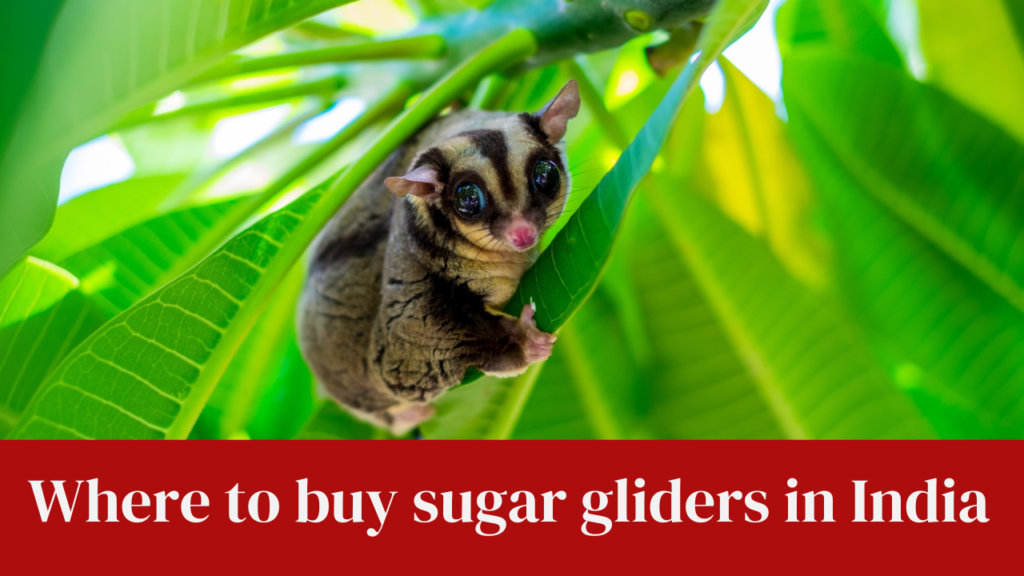
When looking to buy sugar gliders in India, it is important to ensure that you are purchasing them from reputable and licensed sources. Here are some options to consider:
Authorized Exotic Pet Stores: Look for authorized pet stores that specialize in exotic animals. These stores should have the necessary permits and licenses to sell sugar gliders legally. It’s advisable to visit the store in person, observe the conditions in which the animals are kept, and ask questions about their sourcing and care.
Reputable Breeders: Research and find reputable breeders who specialize in sugar gliders. These breeders should have a good reputation for ethical breeding practices, proper care of their animals, and knowledge about sugar glider health and behavior. Ask for references or read reviews from previous customers to ensure their credibility.
Online Classifieds and Websites: Online platforms and classified websites may have listings for sugar gliders. However, exercise caution when using such platforms, as they may have unregulated sellers. Ensure that the seller can provide proper documentation and information about the gliders’ health and lineage before making a purchase.
Exotic Pet Expos and Events: Occasionally, there may be exotic pet expos or events where authorized sellers or breeders showcase and sell sugar gliders. These events can provide an opportunity to interact with the animals, ask questions, and make an informed decision about purchasing a sugar glider.
You May Also Like
Expenses involved in raising a Sugar Glider
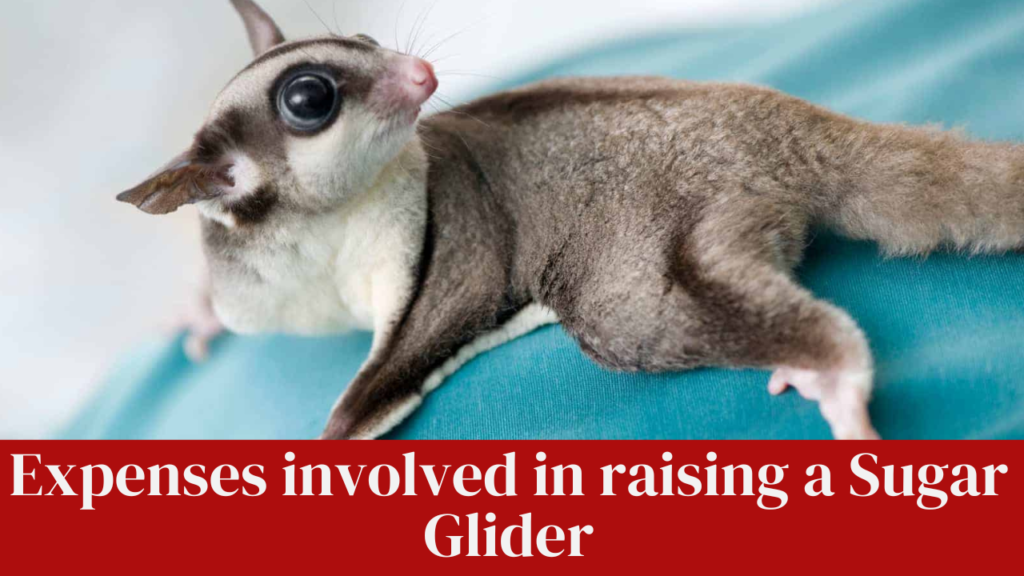
Raising a sugar glider involves various expenses to provide for their care, health, and well-being. Here are some common expenses associated with owning a sugar glider, along with estimated prices for each:
Sugar Glider Purchase: The cost of acquiring a sugar glider can vary depending on factors such as age, lineage, coat color, and breeder reputation. On average, sugar gliders in India can range from ₹8,000 to ₹25,000 or more.
Enclosure and Accessories: You will need to invest in a suitable enclosure or cage for your sugar glider. Prices can vary based on size, quality, and additional features. A decent-sized cage can cost around ₹3,000 to ₹10,000 or more. Other accessories like branches, ropes, hammocks, and nesting boxes may add to the cost, ranging from ₹500 to ₹2,000.
Diet: Sugar gliders require a specialized diet to ensure their nutritional needs are met. This includes a combination of fresh fruits, vegetables, insects, and a specialized sugar glider pellet food. The monthly expense for their diet can range from ₹500 to ₹1,000, depending on the quality and availability of their food.
Veterinary Care: Regular veterinary check-ups are essential for the health and well-being of your sugar glider. These visits may include vaccinations, health examinations, and parasite prevention. The cost of veterinary care can vary, but budgeting around ₹2,000 to ₹5,000 per year for routine check-ups and potential medical expenses is advisable.
Bedding and Litter: Sugar gliders need bedding material in their enclosure for comfort and cleanliness. The cost of bedding materials such as shredded paper, wood shavings, or fleece liners can range from ₹500 to ₹1,000 per month.
Toys and Enrichment: Sugar gliders are intelligent and active animals that require mental and physical stimulation. Budgeting for toys, climbing structures, and enrichment activities can range from ₹500 to ₹1,500 or more, depending on the variety and quality of the items.
Utilities: Sugar gliders require a warm and comfortable environment. Consider the cost of providing heating during colder months or air conditioning during hotter months to maintain suitable temperatures for your glider’s well-being.
Caring for Sugar Gliders
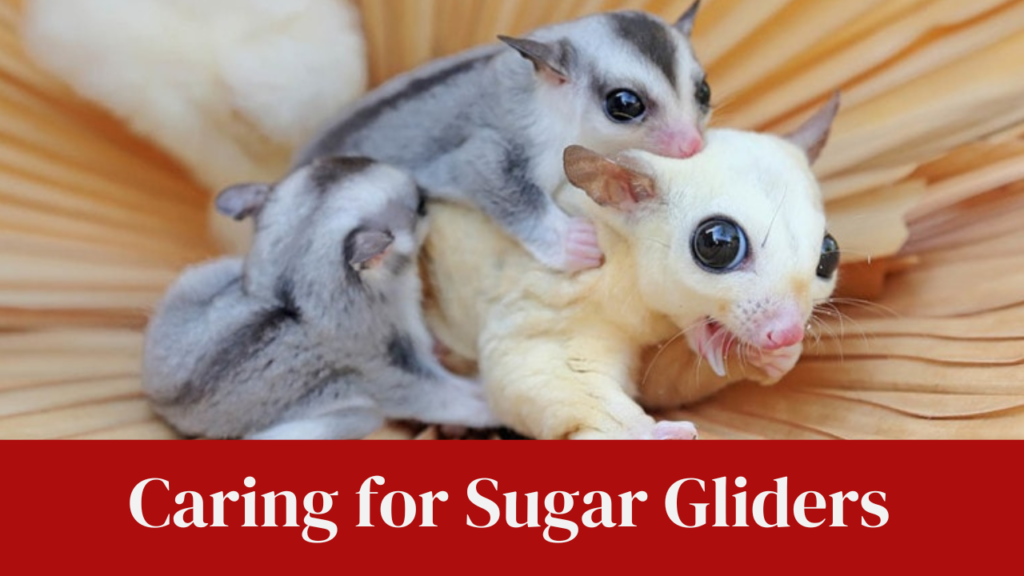
Caring for sugar gliders requires attention to their specific needs and providing a suitable environment for their well-being. Here are some important aspects of sugar glider care:
Housing:
Sugar gliders should be kept in a spacious and secure cage that allows for climbing and gliding. The cage should have multiple levels, branches, ropes, and platforms for them to explore and exercise. Ensure the bar spacing is narrow enough to prevent escape. Provide nesting boxes or pouches for them to sleep in during the day.
Diet:
Sugar gliders are omnivorous and require a balanced diet. Their diet primarily consists of a combination of fresh fruits, vegetables, protein sources (such as cooked chicken or mealworms), and a specialized pellet diet formulated for sugar gliders. It’s important to offer a varied diet to meet their nutritional needs. Avoid feeding them foods that are toxic to them, such as chocolate, caffeine, and onions.
Social Interaction:
Sugar gliders are highly social animals and thrive on social interaction. It’s recommended to keep them in pairs or small groups to meet their social needs. Spend time bonding with your sugar gliders daily, allowing them to interact with you in a safe and controlled manner. This helps strengthen the bond and prevents loneliness and stress.
Environmental Enrichment:
Provide a stimulating environment for your sugar gliders. Offer toys, such as tunnels, ropes, and puzzles, for them to play with and explore. Rotate toys regularly to prevent boredom. Sugar gliders also enjoy climbing, so providing branches and ladders in their cage can enhance their environment.
Exercise and Playtime:
Sugar gliders require regular exercise and playtime outside their cage. Set up a safe and enclosed play area where they can glide, climb, and explore under supervision. Ensure the area is free of hazards, such as toxic plants, electrical wires, or small gaps where they could escape.
Temperature and Lighting:
Sugar gliders are sensitive to temperature extremes. Keep their environment between 70-90°F (21-32°C). Avoid placing their cage in direct sunlight or near drafts. Provide a UVB light source for them to aid in vitamin D synthesis, but ensure they have areas of shade within the cage to avoid excessive exposure.
Veterinary Care:
Schedule regular check-ups with an exotic animal veterinarian experienced in sugar gliders. Routine examinations can help detect any health issues and ensure their well-being. Vaccinations may be recommended based on your location and the specific health risks for sugar gliders in your area.
Bonding and Handling:
Take time to bond with your sugar gliders and establish trust. Start by offering treats from your hand and gradually progress to gentle handling. Avoid grabbing or squeezing them, as this can cause stress and injury. Let them climb on you and explore, allowing for a positive and gradual bonding experience.
Legal requirements for owning a Sugar Glider in India
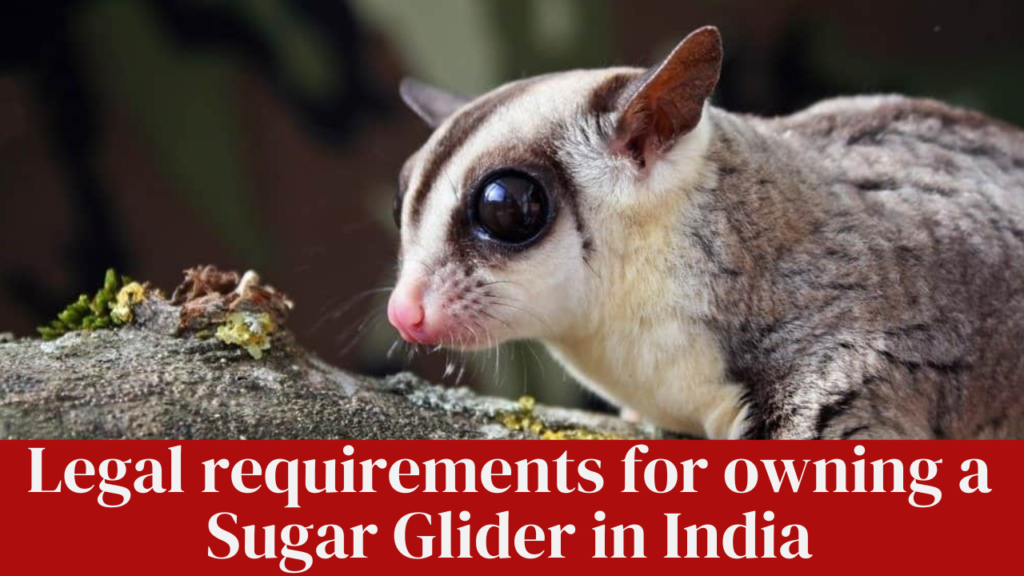
The ownership of exotic animals, including sugar gliders, in India, is subject to legal regulations and restrictions to ensure the welfare of both the animals and the public. Here are the general legal requirements for owning a sugar glider in India:
Wildlife Protection Act: The Wildlife Protection Act of 1972 is the primary legislation governing the protection and conservation of wildlife in India. Sugar gliders are considered exotic animals and are not native to India. Therefore, they fall under the purview of the Wildlife Protection Act.
Schedule I Species: Sugar gliders are not specifically listed under Schedule I of the Wildlife Protection Act, which includes highly protected species. However, the Act prohibits the possession of any animal that is not native to India without proper permits or licenses.
Import and Trade Regulations: Importing sugar gliders into India requires obtaining the necessary permits and complying with the regulations of the Director-General of Foreign Trade (DGFT) and the Convention on International Trade in Endangered Species of Wild Fauna and Flora (CITES). These regulations are in place to prevent illegal wildlife trafficking and protect native wildlife.
State-Specific Regulations: Each state in India may have its own regulations and guidelines regarding the ownership of exotic animals. Some states may require specific permits or licenses to own sugar gliders or other exotic pets. It is important to check with the local forest department or wildlife authorities to determine the specific requirements in your state.
Permits and Licenses: If sugar gliders are legally allowed to be owned as pets in your state, you may need to obtain permits or licenses from the appropriate authorities. These permits may involve submitting an application, providing necessary documentation, and fulfilling specific requirements related to housing, care, and transportation.
Final Thoughts
In conclusion, the price of sugar gliders in India varies depending on various factors such as the age, coloration, lineage, and overall health of the animal. As an exotic pet, sugar gliders require specialized care, including a proper diet, spacious enclosure, and regular veterinary check-ups, which should be considered when assessing their cost. It is important to note that owning a sugar glider comes with responsibilities and commitments to provide a suitable environment and meet their unique needs.
While specific prices cannot be stated definitively, it is recommended to acquire sugar gliders from reputable breeders or licensed exotic pet sellers to ensure the well-being and legality of the transaction. Furthermore, prospective owners should thoroughly research the legal regulations and permits required for keeping sugar gliders as pets in their respective regions.
Ultimately, the price of a sugar glider should not be the sole determining factor when considering adopting one. Potential owners must be ready to devote the necessary time, effort, and resources to provide a happy and healthy life for these unique and captivating creatures.
FAQs
Are Sugar Gliders nocturnal?
Yes, Sugar Gliders are nocturnal creatures. They are most active during the night and have adaptations such as large eyes and a keen sense of smell to navigate in low-light conditions.
Is it legal to own a sugar glider in India?
As of my knowledge cutoff in September 2021, sugar gliders were not specifically listed as banned or regulated animals in India. However, it is essential to check the local laws and regulations in your specific location, as they may vary between states, cities, and housing societies. Some areas may have restrictions or require permits for owning exotic pets.
Can I keep just one sugar glider as a pet?
While it is possible to keep a single sugar glider as a pet, it is generally recommended to have at least two gliders. Sugar gliders are highly social animals and thrive in the company of their own kind. They require social interaction and companionship to lead a happy and fulfilling life. Keeping a single sugar glider may result in loneliness and behavioral issues.
Do sugar gliders have a strong smell?
Sugar gliders have a unique scent that is generally described as musky. However, with proper hygiene and cleaning of their enclosure, the smell should not be overpowering. Regular cage cleaning and maintaining good hygiene practices can help minimize any potential odor associated with sugar gliders.
What is the average lifespan of a sugar glider?
Sugar gliders have an average lifespan of 10 to 15 years when provided with proper care, nutrition, and a suitable environment. With excellent care, some sugar gliders have been known to live beyond 15 years.
Do sugar gliders eat a lot?
Sugar gliders have specific dietary needs, but their actual food intake is relatively small. They are omnivores and consume a combination of fresh fruits, vegetables, a source of protein (such as insects or commercial glider diets), and a calcium supplement. While their portions may appear small, it is important to ensure a balanced diet and provide them with regular meals throughout the day to meet their nutritional requirements.
Can Sugar Gliders be trained?
Yes, Sugar Gliders can be trained using positive reinforcement techniques. They can learn tricks, respond to their names, and even be taught to use a litter box.
Do Sugar Gliders need a lot of space?
Sugar Gliders require a large, vertically-oriented enclosure with plenty of climbing opportunities. A minimum cage size of about 2 feet by 2 feet by 3 feet is recommended, but more space is always beneficial.

